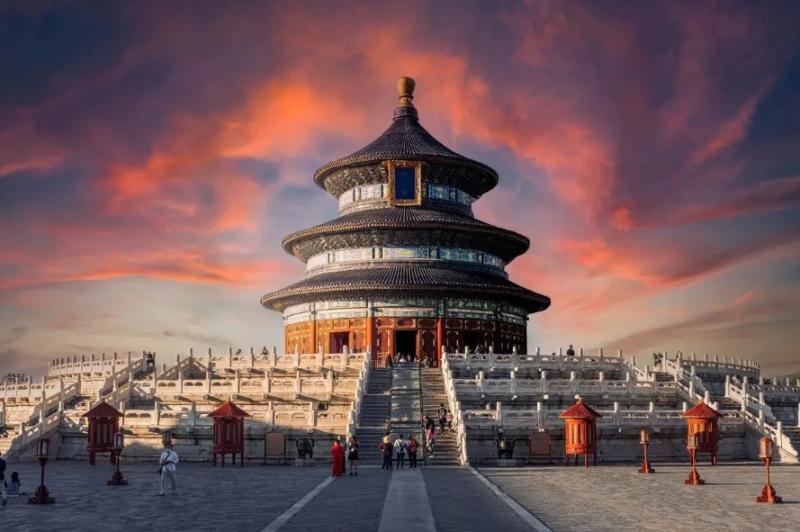Temple of Heaven

The Temple of Heaven: A Sacred Site Where Heaven and Earth Intertwine in Beijing
Nestled in the southern part of central Beijing, the Temple of Heaven is a majestic complex of ancient sacrificial buildings constructed in 1420 during the 18th year of the Yongle reign of the Ming Dynasty. It served as the place where emperors of both the Ming and Qing dynasties worshipped Heaven and prayed for bountiful harvests. With its meticulously planned layout steeped in profound Chinese ancient philosophy and astronomical calendar systems, the Temple of Heaven reflects ancient reverence for Heaven and Earth, and a yearning for a flourishing life. Recognized as a "World Heritage Site," it stands as an outstanding representative of ancient Chinese architectural artistry.
I. Architectural Layout and Design of the Temple of Heaven
The core principle guiding the Temple of Heaven's architectural layout is "heaven is round and earth is square," mirroring the ancient Chinese cosmological concept of a "round heaven and square earth." It also demonstrates the ancient understanding of natural laws and reverence for Heaven and Earth.
-
The Circular Mound Altar: Located at the heart of the Temple of Heaven, the Circular Mound Altar is where emperors performed sacrifices to Heaven. It comprises three circular tiers of stone platforms, symbolizing the three realms of Heaven and Earth. Each tier is adorned with intricate carvings, showcasing the rich heritage of Chinese culture and art. Atop the Circular Mound Altar stands a seven-tiered, white marble sacrificial platform culminating in a circular "Heart of Heaven Stone," representing the center of Heaven and Earth.
-
The Hall of Prayer for Good Harvests: Situated north of the Circular Mound Altar, the Hall of Prayer for Good Harvests is a circular building. Its roof features a double-eaved, hip-and-gable design, symbolizing the blending of Heaven and Earth. The interior boasts exquisite painted decorations, while the roof is adorned with glazed tiles that shimmer golden under the sun, representing the hope for abundant harvests.
-
The Imperial Vault of Heaven: Located west of the Hall of Prayer for Good Harvests, the Imperial Vault of Heaven is another circular building, serving as the place where emperors performed ablutions before sacrificial rituals. The structure's circular top symbolizes Heaven, while its square base represents Earth, signifying the harmonious union of the two. Inside, a tablet dedicated to the Heavenly Emperor is enshrined. Here, emperors engaged in purification rituals, seeking the Heavenly Emperor's blessings.
-
The Palace of Fasts: Situated in the northeastern corner of the Temple of Heaven, the Palace of Fasts served as the place where emperors underwent a period of purification before sacrificial ceremonies. The layout of this building mimics ancient palaces, showcasing the majesty of imperial power. Emperors would spend seven days in this palace, seeking to achieve purity of body and mind, thereby ensuring the bestowal of divine favor from the Heavenly Emperor.
II. Cultural Connotations and Symbolic Significance of the Temple of Heaven
The Temple of Heaven is not merely a collection of buildings but a symbol imbued with profound cultural significance. It reflects the ancient Chinese systems of rites, philosophical thought, and astronomical calendar knowledge.
-
Rituals of Worship to Heaven: As the paramount venue for the Ming and Qing emperors to conduct grand sacrificial ceremonies to Heaven, the Temple of Heaven is a place of utmost significance. The elaborate rituals of worship to Heaven demonstrate the ancient reverence for Heaven and Earth, along with aspirations for a prosperous life. These rituals were presided over by the emperor himself, with participation from numerous officials and commoners, symbolizing the harmonious relationship between the state and Heaven and Earth.
-
The "Unity of Heaven and Man" Philosophy: The Temple of Heaven's architectural design and layout embody the ancient Chinese concept of "unity of heaven and man," which views humanity and nature as a unified and harmonious whole. This philosophy emphasizes respecting natural laws and coexisting harmoniously with Heaven and Earth.
-
Astronomical Calendar Knowledge: The Temple of Heaven's layout and orientation are closely intertwined with astronomical calendar systems, demonstrating the ancient understanding and application of celestial knowledge. For example, the Heart of Heaven Stone at the center of the Circular Mound Altar aligns with the North Celestial Pole, reflecting the ancient perception of the cosmos.
-
Prayers for Bountiful Harvests and National Peace and Prosperity: The Temple of Heaven served as a place for emperors to pray for abundant harvests and peace and prosperity for the nation. It symbolizes the yearning for a flourishing life and the pursuit of happiness.
III. Historical Significance and Modern Value of the Temple of Heaven
As the site where emperors of the Ming and Qing dynasties worshipped Heaven, the Temple of Heaven bears witness to the rise and fall of ancient Chinese dynasties, carrying a wealth of historical and cultural information.
-
Historical Value: The Temple of Heaven, as the center for sacrificial activities during the Ming and Qing dynasties, preserves a wealth of ancient information within its architecture and artifacts, providing invaluable insights into the ancient political systems, cultural thought, and architectural artistry of China.
-
Modern Value: Recognized as a World Heritage Site, the Temple of Heaven possesses significant cultural and tourism value. It serves as a window into ancient Chinese architectural art and cultural thought, acting as an important conduit for people around the world to understand Chinese culture.
-
Future Prospects: With the passage of time, the Temple of Heaven will continue to uphold its cultural value, becoming an important platform for the dissemination of outstanding Chinese traditional culture. Meanwhile, the Temple of Heaven will constantly innovate, offering increasingly diverse cultural experiences to the public and becoming a vital space for enriching people's spiritual and cultural lives.
The Temple of Heaven, a sacred site imbued with history, culture, and spirituality, stands silently in the heart of Beijing, awaiting the exploration of its stories and profound meaning.